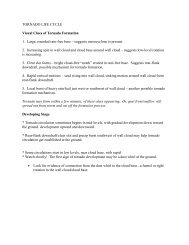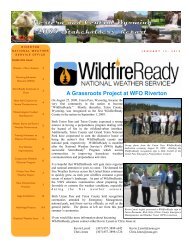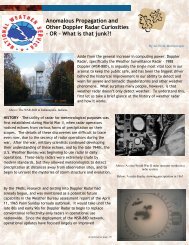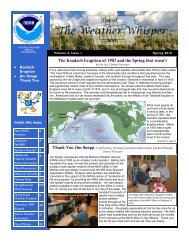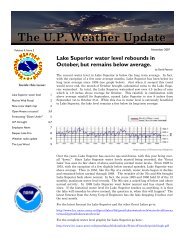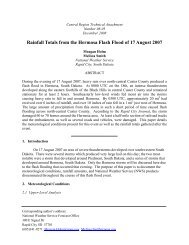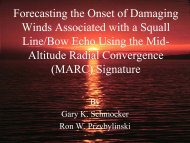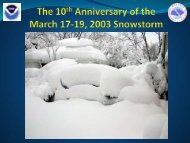Extended Abstract - AMS supported meetings
Extended Abstract - AMS supported meetings
Extended Abstract - AMS supported meetings
Create successful ePaper yourself
Turn your PDF publications into a flip-book with our unique Google optimized e-Paper software.
P8.5 LIGHTNING CLIMATOLOGY FOR THE STATE OF COLORADO<br />
Stephen Hodanish *<br />
Paul Wolyn<br />
NOAA/NWS Pueblo, Colorado<br />
1. INTRODUCTION<br />
This paper documents cloud to ground (CG)<br />
lightning activity over the state of Colorado for a 16<br />
year period; 1989 – 2005, excluding 2000. All data is<br />
from the National Lightning Detection Network<br />
(NLDN) collected by Vaisala. In this study, no attempt<br />
has been made to account for year to year changes in<br />
the detection efficiency of the NLDN. Our primary goal<br />
in this analysis is to show hourly spatial trends in the<br />
data over the Centennial State. A total of 6911280<br />
detected CG flashes were used in this study.<br />
2. DATA PLOTS<br />
All lightning plots in this paper are calculated with<br />
a spatial resolution of 0.2 o latitude by 0.2 o longitude<br />
squares. This corresponds to an approximate<br />
resolution of 400 km 2 for the state of Colorado. In the<br />
first plot, we will discuss the mean annual flash<br />
density over the Centennial State. We then show<br />
flash density plots hour by hour.<br />
3. TOPOGRAPHY OF COLORADO<br />
Before discussing the flash density plots, a<br />
discussion of the states topography is necessary (Fig.<br />
1). A large majority of this discussion was taken<br />
directly from an internet article from the Colorado<br />
Climate Center by Doesken and Pielke (2003).<br />
Emerging gradually from the plains of Kansas<br />
and Nebraska, the high plains of Colorado slope<br />
gently upward for a distance of some 321 km (200 mi)<br />
from the eastern border to the base of the foothills of<br />
the Rocky Mountains. The eastern portion of the State<br />
is generally level to rolling prairie broken by<br />
occasional hills and bluffs. Although subtle when<br />
compared to the high mountains of the Rockies, there<br />
are 3 important topographic features across eastern<br />
Colorado. These topographical features, the<br />
Cheyenne Ridge, the Palmer Divide and the Raton<br />
Mesa are formed by 2 major rivers which dissect the<br />
eastern plains of Colorado - the South Platte River in<br />
northeastern Colorado and the Arkansas River to the<br />
southeast.<br />
_____________________________________<br />
* Corresponding Author Address:<br />
Stephen Hodanish, NOAA/National Weather Service,<br />
3 Eaton Way, Pueblo, CO 81001<br />
Email: Steve.Hodanish@noaa.gov<br />
Elevations along the eastern border of Colorado<br />
range from about 1.0 km (3,350 ft) at the lowest point<br />
in the State where the Arkansas River crosses into<br />
Kansas to near 1.2 km (4,000 ft). Elevations increase<br />
towards the west to between 1.5 km (5,000 ft) and 2.0<br />
km (6,500 ft) where the plains meet the Front Range<br />
of the Rocky Mountain chain. Here elevations rise<br />
abruptly to 2.1 to 2.7 km (7,000 to 9,000 ft). Backing<br />
the foothills are the mountain ranges above 2.7 km<br />
(9,000 ft) with the higher peaks over 4.3 km (14,000<br />
ft). The most dramatic feature is Pike's Peak near<br />
Colorado Springs where elevations rise abruptly from<br />
less then 1.5 km (5,000 ft) near Pueblo in the<br />
Arkansas Valley to over 4.3 km (14,000 ft) at the top<br />
of the mountain. West of these "front ranges" are<br />
additional ranges, generally extending north and<br />
south, but with many spurs and extensions in other<br />
directions. These ranges enclose numerous high<br />
mountain parks and valleys. Farther westward the<br />
mountains give way to rugged plateau country in the<br />
form of high mesas (some more than 3.1 km [10,000<br />
ft] in elevation) which extends to the western border of<br />
the State. This land is often cut by rugged canyons,<br />
the work of the many steams fed by accumulations of<br />
winter snow.<br />
4. FLASH DATA<br />
4.1 ANNUAL<br />
Figure 2 shows the annual flash density for the<br />
state of Colorado. Surprisingly, the greatest flash<br />
amounts are not found across the high mountain<br />
elevations of the Centennial State, but where the<br />
mountains and plains intersect. More specifically, the<br />
Palmer Divide/Pikes Peak region, and to a lesser<br />
extent, the Raton Mesa/Southern Sangre De Cristo<br />
mountains are the lightning “hot spots” in Colorado.<br />
The specific causes for these “hot spots” have<br />
not been investigated, but there are several factors<br />
which may enhance thunderstorm activity. First, the<br />
maximums are on the eastern slopes of the major<br />
mountains which rise from the eastern plains.<br />
Regions of convergence associated with the<br />
mountain/plains circulation may increase the<br />
likelihood for convection. Second, the “hot spots” are<br />
located near major west to east ridges which along<br />
the high plains. These ridges can also provide<br />
regions of convergence in the lower atmosphere<br />
further increasing the chances for convection. Third,<br />
low level moisture from the high plains of Colorado<br />
decrease the stability of the atmosphere near the<br />
mountains. Finally, the “hot spots” occur in the<br />
southern half of Colorado, which will likely have more<br />
moisture associated with the southwest monsoon.
Figure 1. Topographic map of Colorado. Mountain<br />
ranges and place names discussed in text are shown.<br />
Elevation in kFt.<br />
The least amount of CG activity over the<br />
Centennial State is found over the San Luis Valley.<br />
This large broad valley, with an average elevation of<br />
around 2.3 km (7500 ft), is surrounded on 3 sides by<br />
the San Juan Mountain range to the west and<br />
northwest, and the Sangre De Cristo Mountains to the<br />
northeast and east. The lack of lightning activity in this<br />
valley is due primarily to the lack of low level moisture<br />
due to the blocking of the surrounding mountain<br />
ranges. Not surprisingly, the San Luis Valley is also<br />
one of the driest locations in the state of Colorado.<br />
Another noticeable minimum, this time on the<br />
plains, lies in an area bounded by Denver, to Ft<br />
Collins, to Greeley and back to Denver. This minimum<br />
in activity is likely due to a well known meteorological<br />
phenomenon called the Denver Convergence Vorticity<br />
Zone (DCVZ) which forms when synoptic low level<br />
southeasterly flow forms over the plains of Colorado.<br />
This convergence zone typically extends from roughly<br />
Denver to Greeley, and is a favored initiation area for<br />
thunderstorms (See Szoke et al, 2006 this volume).<br />
Once storms develop along this convergence zone,<br />
the prevailing flow carries the convection off in a<br />
general easterly direction. This in turn leaves a void in<br />
CG activity back to the west of the convergence zone.<br />
Although the circulation of the DCVZ leaves a<br />
minimum in CG activity north of Denver, it likely<br />
enhances the lightning activity south of the Denver.<br />
Surface flow to the west of the DCVZ is from a<br />
northerly component. This northerly flow passes the<br />
Denver area and then begins to go upslope over the<br />
north facing side of the Palmer Divide/Pikes Peak<br />
region.<br />
As mentioned in section 3, three areas of higher<br />
terrain extend east-west across the eastern plains;<br />
Figure 2. The mean annual flash density for the State of<br />
Colorado. Nearly 7 million flashes, from 1989 through<br />
2005 (excluding 2000), were processed to produce this<br />
map. No correction for detection efficiency has been<br />
applied.<br />
the Raton Mesa, the Palmer Divide and the Cheyenne<br />
Ridge. From the above discussion, we know that the<br />
Palmer Divide and Raton Mesa are lightning hotspots,<br />
but the Cheyenne Ridge has noticeably less lightning<br />
activity. There are possibly 3 reasons for this. First,<br />
the elevation of the Cheyenne Ridge is not as high as<br />
the other two ridges. Second, less moisture reaches<br />
this region as compared to the other ridges. We<br />
believe this is due to less monsoon moisture reaching<br />
the northern parts of the State (Fig 3). Third, the<br />
circulation of the DCVZ may play a role in the lesser<br />
amount of CG activity over the southern sections of<br />
the Cheyenne Ridge. It should be noted that, although<br />
not shown, there is not a maximum of lightning activity<br />
on the north side of the Cheyenne Ridge in Wyoming.<br />
Of all of the interior mountains (mountains not<br />
adjacent to the plains) in Colorado, the broad San<br />
Juan range shows the most CG activity. This<br />
maximum is believed to be caused by low to mid level<br />
moisture advecting in from Mexico associated with the<br />
Summer Southwest Monsoon (Watson et. al. 1993).<br />
Over Western Colorado, a minimum in lightning<br />
activity can be seen along the major river valleys,<br />
including the Colorado and Gunnison River Valleys. A<br />
minimum in CG activity is also noted across<br />
Northwest Colorado, and extreme Southwest<br />
Colorado.<br />
One of the highest mountain ranges in Colorado,<br />
the Sawatch Range, has the least amount of CG<br />
activity. This range, located in the center of the State,<br />
has numerous 4.0 – 4.3 km (13 - 14 kft) mountains<br />
along its’ flank. The minimum in CG activity over
San Juan Mountains in Southwest Colorado and the<br />
Grand Mesa region in west central Colorado.<br />
During the 18 UTC (Noon MDT) time frame, the<br />
CG activity continues to increase with the high<br />
mountain regions showing the most significant<br />
increases. Flash rates exceeding 0.6 flashes km -2 are<br />
noted once again just east of the spine of the<br />
southern Sangre De Cristo range west of Trinidad, the<br />
Front Range west of Denver and over the San Juan<br />
Mountains. Other areas, such as the Pikes Peak<br />
region, the Grand Mesa, the Roan Mesa and Flat<br />
Tops Mountain region, CG activity increases to 0.4<br />
flashes km -2 . Over the plains, the San Luis Valley and<br />
Northwest Colorado, flash rates remain quite low, with<br />
values below 0.2 flashes km -2<br />
Figure 3. Thirty year average (1971-2000) precipitation<br />
(mm) for Colorado for the months of June, July and<br />
August. Figure composed from Prism Data from Oregon<br />
State University (http://www.prismclimate.org).<br />
this range is due to the lack of lower level moisture<br />
due to the blocking influence of surrounding mountain<br />
ranges.<br />
4.2 HOURLY CG DATA<br />
One of the primary objectives of this study was to<br />
analyze the hour by hour variability in CG flash data<br />
over Colorado. This was done to 1.) Observe when<br />
and where initiation in lightning activity occurs over<br />
the state, and 2.) To observe the spatial changes as<br />
the day progresses. Due to limited space, not all<br />
hourly plots are shown (All hourly plots are shown in<br />
the accompanying poster).<br />
Starting at 12 UTC (6 am MDT; Figure 4) hourly<br />
plot, very little lightning is occurring over the state.<br />
Flash rates are typically less than 0.1 flashes km -2 .<br />
The absolute minimum occurs over a north-south<br />
region of the central part of the state, where, in quite a<br />
few locations, no lightning has been recorded in the<br />
17 year period. The largest flash values at this hour<br />
occur in the western and eastern part of the state.<br />
No significant changes in the hourly plots occur<br />
between 13 and 16 UTC (7 am to 11 am MDT).<br />
Climatologically, 14 UTC (8 am MDT) is the minimum<br />
in CG activity across the State (Table 1).<br />
Noticeable changes occur during the 17 UTC (11<br />
am MDT) time frame as increases of 0.2 to 0.3<br />
flashes km -2 are observed over sections of the<br />
mountains. One maximum is noted west of Denver,<br />
just to the east of Mt Evans. Another maximum is<br />
located west of Trinidad just east of the southern<br />
Sangre de Cristo Mountains. It is of interest that these<br />
two maximums are not occurring directly over the<br />
highest peaks, but just to the immediate east. Other<br />
noticeable maximums at this hour are noted over the<br />
After 19 UTC (1 pm MDT), the highest flash<br />
rates, with some areas exceeding 0.7 flashes km -2 ,<br />
are noted over the Pikes Peak region and the<br />
southern Sangre De Cristo range. Increasing flash<br />
rates are also noted over the San Juan Mountains,<br />
the Front Range, the Roan Plateau and Flat Top<br />
Mountain region. Flash rates are also beginning to<br />
increase over the lower elevations of the Palmer<br />
Divide as the activity begins to “push off” the higher<br />
terrain.<br />
After 20 UTC (2 pm MDT), values increase<br />
statewide with most of the activity once again over the<br />
Pikes Peak/Palmer Divide region and southern<br />
Sangre De Cristo/Raton Mesa region. Flash rates are<br />
at the highest values over the southern Sangre De<br />
Cristo/Raton Mesa region with values in excess of 1.0<br />
flash km -2 . Lightning activity continues to push onto<br />
the plains over the Cheyenne Ridge, Palmer Divide<br />
and Raton Mesa.<br />
During the 21 UTC (3 pm MDT) time frame, peak<br />
flash rates over the mountains of the southern Sangre<br />
De Cristo/Raton Mesa region decrease although the<br />
overall lightning activity over the greater Raton Mesa<br />
region increases. Activity over the greater Pikes<br />
Peak/Palmer Divide region continues to blossom with<br />
flash rates exceeding 1.0 flash km -2 . Lightning over<br />
the San Juan Mountain region shows a noticeable<br />
shift off the mountains towards the west and<br />
southwest. Values over the remainder of the<br />
mountains and higher terrain of Colorado remain<br />
steady, with maximum values around 0.2 to 0.3<br />
flashes km -2 .<br />
Flash rates during the 22 UTC (4 pm MDT) time<br />
frame have reached a peak statewide (See Table 1).<br />
On a regional scale, flash rates are at a maximum<br />
over the Pikes Peak/Palmer Divide area with values<br />
exceeding 1.1 flashes km -2 . Overall, on the plains, CG<br />
activity continues to increase and advance eastward.<br />
As CG activity over the plains is increasing, it is<br />
gradually decreasing over the interior mountains.<br />
Lightning activity in the San Juan mountain region
continues to push towards the south and west over<br />
the lower terrain of far southwest Colorado.<br />
After 23 UTC (5 pm MDT), the maximum lighting<br />
activity continues over Palmer Divide and Raton Mesa<br />
and extends eastward out onto the plains. Flash rates<br />
in excess of 1.0 flash km -2 are still noted over the<br />
plains. Flash rate values continue to decrease over<br />
the remainder of the state, especially over the interior<br />
mountain regions. The only noticeable maximum west<br />
of the Continental Divide is across far Southwest<br />
Colorado.<br />
After 00 UTC (6 pm MDT), flash rates continue to<br />
decrease statewide. The plains continues to show the<br />
maximum in activity. However, flash rates are now<br />
below 1.0 flash km -2 over this region.<br />
From 01 UTC (7 pm MDT) through the 11 UTC (6<br />
am MDT), lightning activity gradually decreases<br />
across the State. At 01 UTC, the highest flash rates<br />
are over the plains and adjacent mountains. A small<br />
secondary maximum is also noted over far Southwest<br />
Colorado. Over the remainder of the interior mountain<br />
areas, flash rates are typically below 0.3 flashes km -2 .<br />
By 04 UTC, flash rates in the mountains are generally<br />
below 0.1 flashes km -2 . Over the plains, flash rates<br />
continue to decrease with the highest values (0.3<br />
flashes km -2 ) noted over the far eastern plains.<br />
By 06 UTC (Midnight MDT), flash rates are<br />
generally below 0.1 flashes km -2 statewide. Many<br />
areas of the interior mountains show no lightning<br />
activity at all. Through the remainder of the early<br />
morning hours the activity continues to slowly<br />
decrease.<br />
5 DISCUSSION<br />
This study analyzed the CG activity over the<br />
State of Colorado over a 16 year period. The mean<br />
annual flash density map showed most of the CG<br />
activity occurs over the Pikes Peak/Palmer Divide<br />
region and across the east facing slopes of the<br />
Southern Sangre De Cristo mountain range/Raton<br />
Mesa region.<br />
Minimum in CG activity was found over the San<br />
Luis Valley. Somewhat surprisingly, a minimum in<br />
activity was noted north of Denver to Ft Collins and<br />
across the northern sections of the Front Range.<br />
Minimum in activity was also noted over one of the<br />
highest mountain ranges in Colorado, the Sawatch<br />
Range.<br />
Of interest, initial lightning “hotspots” were not<br />
found directly over the higher mountain peaks, but<br />
just to the east of the higher peaks.<br />
As found by Lo´pez and Holle (1986), lightning<br />
begins to increase over the higher terrain of Colorado<br />
around 17 UTC (11 am MDT).<br />
The overall minimum in activity occurs over the<br />
State during 14 UTC (8 am MDT), the maximum<br />
occurs around 22 UTC (4 pm MDT).<br />
The hourly plots show that the lightning activity<br />
which develop along the mountains adjacent to the<br />
plains moves east as the afternoon progresses. Over<br />
the San Juan mountain region, the activity moves in a<br />
general southwest direction during this same time<br />
period.<br />
6 ACKNOWLEDGMENTS<br />
The Authors would like thank Bill Fortune (MIC<br />
NWS Pueblo CO) for his support, and Irv Watson<br />
(SOO NWS Tallahassee FL). Precipitation data was<br />
supplied by the Prism Group, Copyright 2006, Oregon<br />
State University, http://www.prismclimate.org. The<br />
Prism data was downloaded 10 August 2006.<br />
7 REFERENCES<br />
Doesken, N. J., and R. A. Pielke, 2003: Climate of<br />
Colorado. Internet document:<br />
http://ccc.atmos.colostate.edu/climateofcolorado.php<br />
López, R. E., and R. L. Holle, 1986: Diurnal and<br />
spatial variability of lightning activity in northeastern<br />
Colorado and central Florida during the summer.<br />
Mon. Wea. Rev., 114, 1288–1312.<br />
Szoke, J., D. Barjenbruch and R. Glancy, 2006: The<br />
Denver Cyclone and tornadoes 25 years later: the<br />
continued challenge of predicting non-supercell<br />
tornadoes. <strong>AMS</strong> 26 Severe Local Storms Conf., St<br />
Louis, MO (this volume).<br />
Watson, A. I., R. L. Holle, and R. E. López, 1993:<br />
Cloud-to-ground lightning and upper-air patterns<br />
during bursts and breaks in the Southwest Monsoon.<br />
Mon. Wea. Rev., 122, 726–1739.
Table 1. Average number of CG flashes by hour for each month over the state of Colorado. Average (AVE/DAY) flashes per<br />
day for each month are also shown (bottom). “TOTAL” values are total number of flashes for those months and hours used<br />
in this study. The maximum hourly CG activity occurs at 22 UTC while the minimum occurs at 14 UTC. August has the<br />
highest flash values followed closely by July. As mentioned in the text, this study does not account for the year to year changes<br />
in the detection efficiencies of the NLDN, so the values in this table are higher than shown.<br />
HR<br />
(UTC) JAN FEB MAR APR MAY JUN JUL AUG SEP OCT NOV DEC TOTAL<br />
12 0.1 0.1 0.3 1.6 5.0 9.6 5.6 19.8 13.0 3.9 0.1 0 28929<br />
13 0 0.1 0.3 1.4 4.8 9.1 3.8 16.6 13.6 2.9 0.1 0 25740<br />
14 0 0 0.3 1.3 5.1 6.7 3.6 12.9 14.4 3.0 0.1 0 23202<br />
15 0 0 0.1 1.6 5.7 6.8 3.3 12.9 14.5 4.3 0.1 0 24028<br />
16 0 0 0.1 2.5 11.0 14.1 8.2 14.9 14.9 4.4 0.1 0 34369<br />
17 0 0 0.4 4.8 27.7 46.0 39.3 45.3 24.9 5.6 0.4 0 95172<br />
18 0 0.1 1.3 10.3 60.7 114.4 130.8 138.5 54.9 8.2 0.5 0 254907<br />
19 0 0.3 2.9 16.4 97.2 187.3 272.9 272.4 96.3 12.8 0.9 0 471058<br />
20 0 0.5 4.7 21.8 132.4 239.4 396.1 377.4 137.2 15.5 0.9 0 651235<br />
21 0 0.7 5.2 25.5 146.6 286.5 479.3 464.3 150.3 20.9 0.9 0.1 776372<br />
22 0 0.6 5.8 25.7 151.7 300.9 523.0 521.2 165.9 22.9 0.9 0.1 844535<br />
23 0.1 0.6 5.4 22.2 136.2 298.8 505.0 521.5 154.9 21.7 1.0 0 819420<br />
00 0.1 0.3 3.8 21.2 105.7 278.0 433.5 486.5 146.3 25.7 0.7 0.1 737734<br />
01 0 0.2 2.3 17.5 87.8 223.9 358.1 388.4 112.6 21.8 0.7 0.1 596101<br />
02 0.1 0.1 1.4 11.5 66.9 166.7 279.5 286.9 87.9 20.2 1.0 0 453139<br />
03 0 0.1 0.9 8.4 51.4 117.3 198.2 195.4 66.7 13.3 0.9 0.1 320595<br />
04 0.1 0.1 0.8 7.3 34.8 84.0 144.3 134.0 51.1 11.3 0.6 0 229965<br />
05 0.1 0.1 0.6 7.2 22.3 64.7 91.1 91.4 37.4 10.9 0.4 0 160044<br />
06 0.1 0 0.6 5.4 15.7 51.7 59.9 65.1 26.4 7.4 0.1 0 114023<br />
07 0.4 0 0.4 3.1 11.4 39.3 36.1 48.4 19.5 5.6 0.2 0 80556<br />
08 0.1 0 0.4 2.3 8.4 27.9 26.3 35.7 15.6 5.8 0.2 0 60158<br />
09 0.1 0 0.6 2.0 5.6 19.5 16.2 27.5 14.2 4.4 0.1 0 44211<br />
10 0.1 0 0.5 1.7 5.1 15.7 12.1 19.9 12.4 4.3 0.2 0 35158<br />
11 0 0.1 0.2 1.8 4.2 12.8 8.6 18.5 11.8 4.4 0.2 0 30629<br />
Ave/<br />
day 1.4 4.0 39.3 224.5 1203.4 2621.1 4034.8 4215.4 1456.7 261.2 11.3 0.5<br />
Total 806 1913 19404 107757 596772 1258117 2001217 2090775 699250 129616 5384 269 6911280<br />
Figure 4. Hourly flash density maps for the state of Colorado for 12, 16 and 17 UTC.<br />
Figure 4 (continued on next page). Hourly flash density maps for the state of Colorado for 18, 19, 20, 21, 22, 23, 00, 01, 02<br />
03, 06 and 09 UTC.




